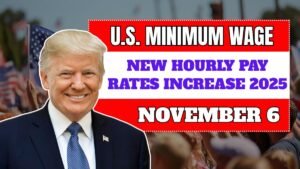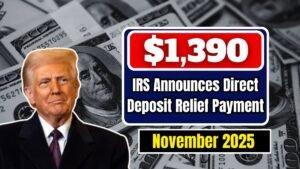The U.S. government did another important thing in November 2025 by providing economic relief to the people who were affected by the price increases. The IRS (Internal Revenue Service) has now started a new program called “IRS Inflation Stimulus 2025,” under which the eligible individuals in the USA will be getting $1,390 through direct deposits. The relief plan mainly aims at the households and the individuals whose basic expenses, such as food, fuel, rent, and medical care, have gone up significantly.
Why the IRS Launched the $1,390 Inflation Relief Program
In the United States, the cost of living has been constantly rising for several years. The surge in food prices, housing rents, healthcare, and transportation is not going to stop anytime soon. As a result, the IRS has come up with a relief program for the people belonging to the middle and low-income classes.
This program is a Targeted Relief one, meaning that only those who are really affected will receive the financial aid. This action is part of the government’s grand economic recovery plan, which aims at creating a durable stability by the year 2026.
Who is eligible for this relief amount?
Eligibility for IRS Inflation Stimulus 2025 is primarily based on 2024 tax returns and income limits.
- Single taxpayers with annual incomes less than $75,000 will receive $1,390.
- Married couples who file taxes jointly and have a combined income of less than $150,000 will receive $2,780 in assistance.
- Dependents may also receive a partial credit, depending on their family’s income and tax filing.
Besides, people who get Social Security (SSA), Supplemental Security Income (SSI), or Social Security Disability Insurance (SSDI) are eligible for this program straight away. If they have their bank account information up to date with either the IRS or SSA, no separate application will be required.
[also_read id=”2770″]
When and how will payments be made
The IRS timetable indicates that payments have started to be processed in the first week of November 2025. Those taxpayers that submitted their returns ahead of the deadline and whose bank information is current in the IRS records will get the money transferred to their accounts within a span of three to five banking days.
Those who do not maintain a bank account or have not provided their bank details will get the money via a paper check. Nevertheless, there may be some delays owing to overloaded postal services.
The transaction will be identified on bank statements as “IRS TREAS 310 – TAX RELIEF”.
Social Security recipients will have the money credited to their Direct Express Card automatically.
The IRS recommends all the beneficiaries to keep an eye on their bank alerts and notifications and to ignore any emails or websites that may ask for personal information under the pretense of a fraudulent update.
How this plan differs from previous stimulus plans
Most taxpayers received the same amount in COVID-19 pandemic stimulus checks. Nonetheless, the IRS Inflation Relief Program of 2025 is a different case—it is intended solely for those who have been most hurt by inflation.
This program is an example of a targeted intervention; it is not merely the distribution of money to the population at large. Its funding comes from the Federal Reserve’s financial resources and the budget surplus. Its goal is to give people the ability to meet their most basic needs while the government slowly transitions through reforms to a stable economy in the long run.
The government has indicated that this payment is a one-off support and that it will not be disbursed every month or every quarter. According to experts, the relief measure taken is temporary but important and consequently, it will facilitate the economy by lowering inflation and fostering consumer confidence.
How to Check Your Payment Status Online
The IRS has updated a tool called “Get My Payment” on its official portal, allowing citizens to easily check their payment status. This tool allows you to:
- Verify your eligibility,
- Get information about the amount you are receiving,
- And see when your direct deposit or check will be issued.
If a person’s bank account or home address has been altered, he/she must change his/her details on the IRS’s official site without delay so that the payment does not get postponed.
The IRS has warned that taxpayers should consider the IRS.gov domain as the only source of their information because a lot of con artists are attempting to get people’s confidential data through fake websites.
Government’s Macroeconomic Strategy 2025
The US government has included this relief plan among the actions taken for the macroeconomic stabilization strategy. The plans of the Federal officials are to provide short-term support to the population and at the same time keep inflation under control.
During the same time, the Fed has been gently adjusting its policy to a point where the interest rates will not cause the employment sector to suffer. The administration is confident that the inflation rate will return to its normal levels by the middle of 2026. This, in turn, will result in a higher purchasing power for both the economy and the consumers.
The 2026 Economic Recovery Package has already been presented and it suggests changes that will significantly impact the areas of healthcare cost reduction, housing affordability, and wage increases. In the meantime, this $1,390 relief payment will be a source of support for millions of Americans until the long-term reforms take place.
[also_read id=”2951″]
Conclusion
The $1,390 IRS direct deposit program will not only be a tool in easing off the inflation but also provide a bit of extra financial comfort around the holidays for the lower and middle-income families. The program is, in fact, a strong signal to the people that the US government is conscious of the hard times and willing to offer financial help.
The relief will be short-lived, but its impacts may be felt for a long time; when people are somewhat economically secured they will not only trust the economy even more but also scale down their consumption. Such incremental but important steps will be the United States’ way to a strong and secured economic future in the coming years.
FAQs
Q1. Who is eligible for the $1,390 IRS payment?
Single filers earning under $75,000 and married couples earning under $150,000 qualify.
Q2. Do Social Security recipients need to apply?
No, SSA, SSI, and SSDI beneficiaries will receive payments automatically.
Q3. When will payments be sent?
Payments began in early November 2025 and continue through the month.
Q4. How will I receive the money?
Through direct deposit or paper checks, depending on IRS records.
Q5. Is this a recurring payment?
No, the $1,390 payment is a one-time inflation relief measure.



